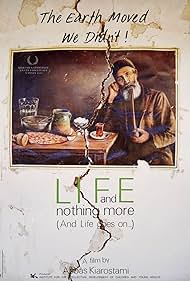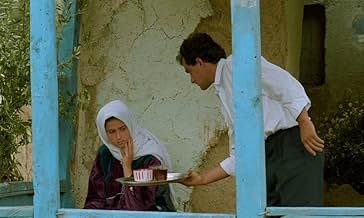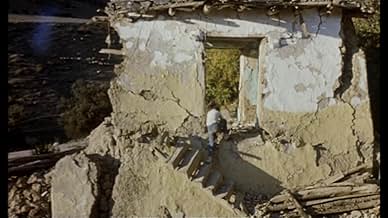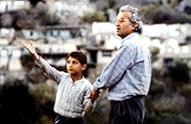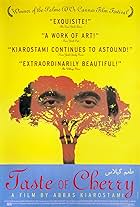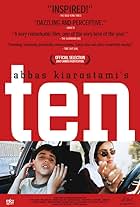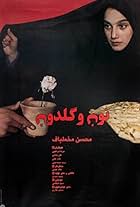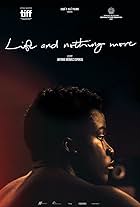IMDb RATING
7.9/10
7.9K
YOUR RATING
A director and his son return to a region damaged by the Guilan earthquake, hoping to find the children who appeared in his film a few years earlier.A director and his son return to a region damaged by the Guilan earthquake, hoping to find the children who appeared in his film a few years earlier.A director and his son return to a region damaged by the Guilan earthquake, hoping to find the children who appeared in his film a few years earlier.
- Awards
- 1 win & 2 nominations
- Director
- Writer
- All cast & crew
- Production, box office & more at IMDbPro
Storyline
Did you know
- TriviaIn 1990, an earthquake devastated the area around the farming village of Koker in Iran, killing 50,000 people, including 20,000 children. Abbas Kiarostami and his 11 year old son Bahman drove to Koker to try to find the two boys who acted in his film "Where is the Friend's House." When he later told an audience in Germany about the journey, someone suggested that he turn the story into a film and he began filming a short while later.
- ConnectionsFeatured in Through the Olive Trees (1994)
- SoundtracksConcerto in F Major for Two Horns, RV 539: II. Larghetto
Written by Antonio Vivaldi
Performed by Orchestra of the Age of Enlightenment
Featured review
Zendegi va digar hich (1992) is an Iranian movie shown in the U.S. with the translated title "And Life Goes On." The film was written and directed by Abbas Kiarostami.
The movie is part of a series of films entitled "The Koker Trilogy." Koker is a small village northwest of Tehran. No one outside Iran would know anything about Koker, except for Kiarostami's films. He used Koker as the setting for the first film in the trilogy--Where is the Friend's House? (1987) (I loved this movie. It has an amazing IMDb rating of 8.1.)
After that movie, people may have vaguely remembered Koker. However, the trilogy has made it famous among Iranians and among cinephiles.
Koker is famous because of a horrible tragedy that took place on June 21, 1990. A devastating earthquake destroyed Koker and many surrounding villages. The loss of life was immense. Almost all the buildings were destroyed.
In real life, director Kiarostami and his son traveled to Koker five days after the earthquake occurred. They wanted to find out if the two brothers who starred in the earlier film had survived the earthquake.
Kiarostami turned his trip into this movie. He found that despite the immense grief felt by the local people, life did, indeed, go on.
Farhad Kheradmand starred as the film director (Kiarostami), and Buba Bayour stared as his son Puya. Neither is a professional actor, but you could never tell that from their performances, which are superb. (Bayour never acted again. Kheradmand appeared again in the third movie of the trilogy--Through the Olive Trees.)
Basically, this movie is a quest movie. The father and his young son are determined to find the young boys, and the immensity of the tragedy continually puts obstacles in their way.
Kiarostami is famous for using panoramic long shots, and this is what we see at the end of the film. The closing long shot is one of the most powerful film endings I've ever seen.
This is an amazing film. It has a very high IMDb rating of 7.9. I rated it 10. It worked well enough on the small screen, but of course it would be better in a theater. We saw it on a Criterion DVD, sold with the other two movies in the the trilogy. The films may be available separately, which would be OK. However, the Criterion edition has many video extras, along with a written essay by noted film critic Godfrey Cheshire.
This a wonderful movie--I would say it's a must-see if you love great cinema. Find it and watch it.
IMPORTANT: The trilogy should be seen in order of production: Where is the Friend's House?, then And Life Goes On, then Through the Olive Trees. The movies won't work as well if seen out of their order.
The movie is part of a series of films entitled "The Koker Trilogy." Koker is a small village northwest of Tehran. No one outside Iran would know anything about Koker, except for Kiarostami's films. He used Koker as the setting for the first film in the trilogy--Where is the Friend's House? (1987) (I loved this movie. It has an amazing IMDb rating of 8.1.)
After that movie, people may have vaguely remembered Koker. However, the trilogy has made it famous among Iranians and among cinephiles.
Koker is famous because of a horrible tragedy that took place on June 21, 1990. A devastating earthquake destroyed Koker and many surrounding villages. The loss of life was immense. Almost all the buildings were destroyed.
In real life, director Kiarostami and his son traveled to Koker five days after the earthquake occurred. They wanted to find out if the two brothers who starred in the earlier film had survived the earthquake.
Kiarostami turned his trip into this movie. He found that despite the immense grief felt by the local people, life did, indeed, go on.
Farhad Kheradmand starred as the film director (Kiarostami), and Buba Bayour stared as his son Puya. Neither is a professional actor, but you could never tell that from their performances, which are superb. (Bayour never acted again. Kheradmand appeared again in the third movie of the trilogy--Through the Olive Trees.)
Basically, this movie is a quest movie. The father and his young son are determined to find the young boys, and the immensity of the tragedy continually puts obstacles in their way.
Kiarostami is famous for using panoramic long shots, and this is what we see at the end of the film. The closing long shot is one of the most powerful film endings I've ever seen.
This is an amazing film. It has a very high IMDb rating of 7.9. I rated it 10. It worked well enough on the small screen, but of course it would be better in a theater. We saw it on a Criterion DVD, sold with the other two movies in the the trilogy. The films may be available separately, which would be OK. However, the Criterion edition has many video extras, along with a written essay by noted film critic Godfrey Cheshire.
This a wonderful movie--I would say it's a must-see if you love great cinema. Find it and watch it.
IMPORTANT: The trilogy should be seen in order of production: Where is the Friend's House?, then And Life Goes On, then Through the Olive Trees. The movies won't work as well if seen out of their order.
- How long is And Life Goes On?Powered by Alexa
Details
- Release date
- Country of origin
- Official site
- Language
- Also known as
- Life and Nothing More...
- Filming locations
- Production companies
- See more company credits at IMDbPro
Contribute to this page
Suggest an edit or add missing content

